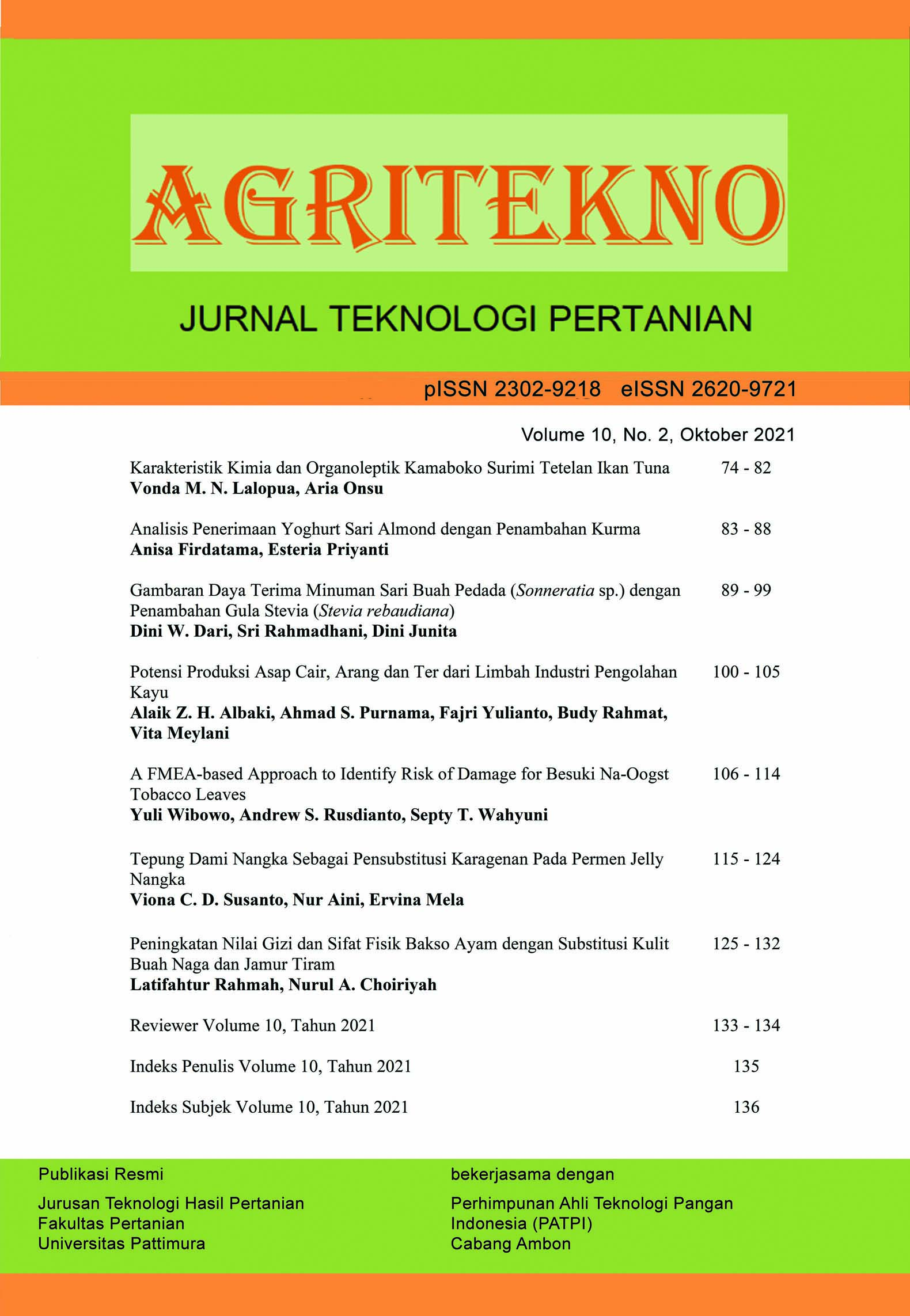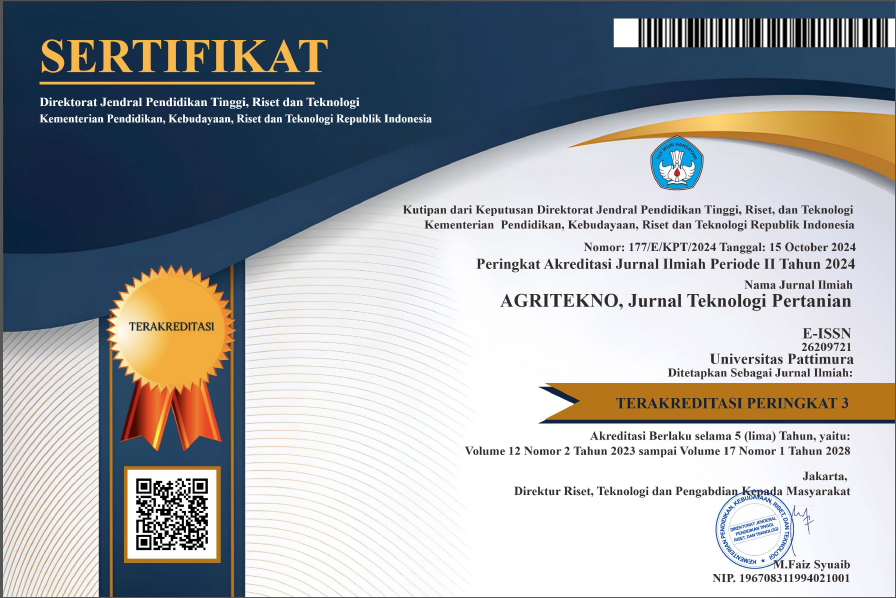A FMEA-based Approach to Identify Risk of Damage for Besuki Na-Oogst Tobacco Leaves
Identifikasi Risiko Kerusakan Daun Tembakau Besuki Na-Oogst Menggunakan Pendekatan berbasis FMEA
Abstract
Besuki Na-Oogst tobacco is a type of plantation commodity that requires special handling. Improper post-harvest handling increases the risks of being damaged. This study aimed to identify the types of damage to Besuki Na‑Oogst tobacco leaves, analyze the risk level of damage to Besuki Na-Oogst tobacco leaves, and provide recommendations for risk control of tobacco leaves damage. The Failure Mode and Effect Analysis method was applied to Identify the Besuki Na-Oogst tobacco leaves risk damages. This method can determine the value of severity, occurrence, and detection to obtain a critical Risk Priority Number (RPN) that indicates the most critical level of risk. The results showed that the types of damage to Besuki Na-Oogst tobacco leaf classified as having a high-risk impact were perforated leaves, oily leaves, white spots, blue spots, and moldy leaves indicated by RPN values greater than the critical value. If these risks are not appropriately handled, it can decrease the quality of the tobacco leaves, resulting in losses. The risk control of leaf damage is based on risk-causing factors in suggestions for improvements that the management can follow up.
Keywords: Besuki Na-Oogst tobacco leaves; critical value; FMEA; risk; RPN
ABSTRAK
Tembakau Besuki Na-Oogst merupakan jenis komoditas perkebunan yang memerlukan penanganan khusus. Penanganan pasca panen yang tidak tepat menimbulkan risiko yang tidak diinginkan yaitu daun tembakau menjadi rusak. Penelitian ini bertujuan untuk mengidentifikasi jenis kerusakan daun tembakau Besuki Na-Oogst, menganalisis tingkat risiko kerusakan daun tembakau Besuki Na-Oogst, dan memberikan rekomendasi pengendalian risiko kerusakan daun tembakau. Identifikasi risiko kerusakan daun tembakau Besuki Na-Oogst menggunakan metode Failure Mode and Effect Analysis. Metode ini dapat digunakan untuk menentukan nilai keparahan, kejadian, dan deteksi untuk mendapatkan risk priority number kritis yang menunjukkan tingkat risiko paling kritis. Hasil penelitian menunjukkan bahwa jenis kerusakan pada daun tembakau Besuki Na-Oogst yang tergolong berisiko tinggi adalah daun berlubang, daun berminyak, bercak putih, bercak biru, dan daun berjamur yang ditunjukkan dengan nilai RPN lebih besar dari nilai kritis. Jika risiko tersebut tidak ditangani dengan baik, maka daun tembakau akan mengalami penurunan kualitas yang dapat mengakibatkan kerugian. Pengendalian risiko kerusakan daun tembakau didasarkan pada faktor penyebab risiko berupa saran perbaikan yang dapat ditindaklanjuti oleh pihak perusahaan.
Kata kunci: Daun tembakau Besuki Na-Oogst; FMEA; nilai kritis; risiko; RPN
Downloads
References
Arifandi, J.A., A. Wardhono, dan Y. Indrawati. 2018. Panduan Praktik Budidaya Tembakau Besuki Na-Oogst. Jember: Pustaka Abadi.
Asadi, Z. 2015. An investigation of risk management strategies in projects. Marketing and Branding Research 2: 89-100. DOI: 10.19237/MBR.2015.01.07.
BPS. 2017. Jawa Timur Province in Figures 2016. Biro Pusat Statistik. Jawa Timur.
Chapman, C., and S. Ward. 2003. Project Risk Management: Processes, Techniques and Insights. England: John Wiley & Sons.
Chrysler, LLC., F.M. Company, and G.M. Corporation. 2008. Potential Failure Mode and Effects Analysis (FMEA) Reference Manual Fourth Edition. Adare Ltd.: AIAG.
Da Ré, A.F., L.G. Gurgel, G. Buffon, W.E.R. Moura, D.C.G.M. Vidor, and M.A.P. Maahs. 2018. Tobacco influence on taste and smell: Systematic review of the literature. International Archives of Otorhinolaryngology 22: 81-87. DOI: 10.1055/s-0036-1597921
de Dianous, V. and C. Fiévez. 2006. ARAMIS project: A more explicit demonstration of risk control through the use of bow-tie diagrams and the evaluation of safety barrier performance. Journal of Hazardous Materials 130(3 SPEC. ISS.): 220-233. DOI: 10.1016/j.jhazmat.2005.07.010.
de Souza, V.B. and C.R. Carpinetti. 2014. A FMEA-based approach to prioritize waste reduction in lean implementation. International Journal of Quality & Reliability Management 31: 346-366.
Disbun Jatim. 2011. Panduan Budidaya dan Pengolahan Hasil Tembakau (Good Tobacco Practices) Tembakau Besuki Na-Ogst. Dinas Perkebunan Provinsi Jawa TImur.
Djajadi, D. 2015. Tobacco diversity in Indonesia. Berkala Penelitian Hayati 20: 27-32. DOI: 10.23869/bphjbr.20.2.20155
Doshi, J., and D. Desai. 2017. Application of failure mode & effect analysis (FMEA) for continuous quality improvement-multiple case studies in automobile SMEs. International Journal for Quality Research 11: 345-360. DOI: 10.18421/IJQR11.02-07.
Hollnagel, E. 2008. Barriers and Accident Prevention. Aldershot, Hampshire, England ; Burlington, VT: Ashgate.
Kang, J., L. Sun, H. Sun, and C. Wu. 2017. Risk assessment of floating offshore wind turbine based on correlation-FMEA. Ocean Engineering 129: 382-388. DOI: 10.1016/j.oceaneng.2016.11.048.
Kathirvel, N., K. Naveena, R. Scholar, S. Sheeba, and J. Roseleen. 2019. Studies on the biology of cigarette beetle, Lasioderma serricorne (F.) (Coleoptera: Anobiidae) in turmeric powder acaricide resistance management strategy view project storage entomology view project studies on the biology of cigarette beetle, Lasioderma. International Journal of Chemical Studies 7: 2792-2794.
Kementan. 2012. Peraturan Menteri Pertanian Republik Indonesia Nomor 55 Permentan/OT.140/9/2012 Tentang Pedoman Penanganan Pascapanen Lada. Menteri Kesehatan Republik Indonesia Peraturan Menteri Kesehatan Republik Indonesia, Nomor 65(879), 2004-2006.
Khorwatt, E. 2015. Assessment of business risk and control risk in the Libyan Context. Open Journal of Accounting 04: 1-9. DOI: 10.4236/ojacct.2015.41001.
Kim, B.S., E.M. Shin, Y.J. Park, and J.O. Yang. 2020. Susceptibility of the cigarette beetle Lasioderma serricorne (Fabricius) to phosphine, ethyl formate and their combination, and the sorption and desorption of fumigants on cured tobacco leaves. Insects 11: 1-13. DOI: 10.3390/insects11090599.
Muksin, and C.T. Widianto. 2017. Core process and potencial problems in activities Na-Oogst tobacco agribussines ini Jember Regency. Seminar Nasional Hasil Penelitian 2017. p. 375.
Nisa, A.C., R. Wibowo, dan M. Rondhi. 2017. Strategi peningkatan mutu tembakau Besuki Na-Oogst di PTPN X Kebun Kertosari Jember. Jurnal Manajemen dan Agribisnis 14: 174-185. DOI: 10.17358/jma.14.2.174.
Ookalkar, A., A.G. Joshi, and S.D. Ookalkar. 2009. Quality improvement in haemodialysis process using FMEA. International Journal of Quality & Reliability Management 26: 817-830.
Ora, A., D. Kumar, and N. Darade. 2017. Failure mode effect analysis with pareto chart for various critical equipment used in ceramic industry. International Journal of Engineering Science and Computing 7: 10168-10173.
Pratama, A.L.Y., S. Soetriono, and J. Januar. 2018. The farm risk management of Besuki Na-Oogst tobacco in Tanjungrejo Village, Jember Regency. Agricultural Social Economic Journal 18: 13-22. DOI: 10.21776/ub.agrise.2018.018.1.3.
Putri, E.A., A. Suwandari, dan J.A. Ridjal. 2015. Analisis pendapatan dan efisiensi biaya usahatani tembakau Maesan 2 di Kabupaten Bondowoso. JSEP 8: 64-69.
Rakesh, R., B.C. Jos, and G. Mathew. 2013. FMEA analysis for reducing breakdowns of a sub system in the life care product manufacturing industry. International Journal of Engineering Science and Innovative Technology 2: 218-225.
Roelen, A., R. van Aalst, N. Karanikas, S. Kaspers, S. Piric, and R.J. de Boer. 2018. Effectiveness of risk controls as indicator of safety performance. AUP Advances 1: 175-189. DOI: 10.5117/adv2018.1.012.roel.
Supriyadi, N.E. Diana, and Parnidi. 2021. Effect of plant population on productivity and besuki cigar tobacco Quality NO. Lentera Bio: Berkala Ilmiah Biologi 10: 159-164.
Sutrisno, A., and T.J. Lee. 2012. Service reliability assessment using failure mode and effect analysis (FMEA): Survey and opportunity roadmap. International Journal of Engineering, Science and Technology 3: 25-38. DOI: 10.4314/ijest.v3i7.3s
Titosastro, S., dan W. Musholaeni. 2015. Penanganan panen dan pasca panen tembakau di Kabupaten Bojonegoro. Jurnal Buana Sains 15: 155-164.
Wardhono, A., J.A. Arifandi, Y. Indrawati, M.A. Nasir, and C.G. Qori’ah. 2021. Improving tobacco Besuki Na-Oogst competitiveness: Does tobacco still at a crossroads? Journal of Management and Business Environment 2: 141-161. DOI: 10.24167/jmbe.v2i2.2909.
Widianti, T., dan H. Firdaus. 2017. Penilaian Risiko Instansi Pemerintah dengan Fuzzy-Failure Mode and Effect Analysis. LIPI.
Yin, R.K. 2009. Case Study Research: Design and Methods (4th ed.). Thousand Oaks, Calif.: Sage Publications.
Copyright (c) 2021 The Authors

This work is licensed under a Creative Commons Attribution-ShareAlike 4.0 International License.
Authors who publish with this journal agree to the following terms:
- Authors retain copyright and grant the journal the right of first publication with the work simultaneously licensed under a Creative Commons Attribution License that allows others to share the work with an acknowledgement of the work's authorship and initial publication in this journal.
- Authors are able to enter into separate, additional contractual arrangements for the non-exclusive distribution of the journal's published version of the work (e.g., post it to an institutional repository or publish it in a book), with an acknowledgement of its initial publication in this journal.
- Authors are permitted and encouraged to post their work online (e.g., in institutional repositories or on their website) prior to and during the submission process, as it can lead to productive exchanges, as well as earlier and greater citation of published work (See The Effect of Open Access).









